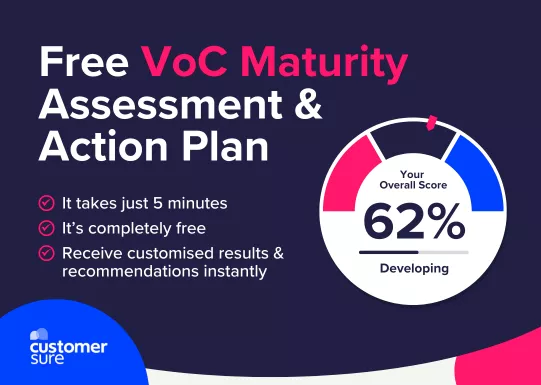

Everyone wants to know how they measure up to others. At school, in sports, sometimes even in the office, league tables abound.
Customer feedback is no different. If you want to know how your NPS score shapes up, there’s a whole site for that. Which is good, right? It’s important to know how we’re doing against the competition?
We work with some of the best companies on earth at collecting and responding to feedback, and we’ve learned a lot about how they approach satisfaction benchmarking – lessons we’ll gladly share with you.
But benchmarking and great customer service go together like tuna and custard.
Let’s talk about why…
The short answer is, don’t benchmark because there’s no benefit to your customers, and as a consequence, your business.
It has no more value than gossip.
We agree, it’s interesting. It’s fascinating to know how you’re doing compared to other companies and your competitors.
But the only money to be made in this area is by the companies who charge for benchmark data, and such is the appetite for the data that they’re doing very well.
The value of customer satisfaction benchmarks is best summed up by the great customer protagonist, Tom Peters:
“How does it help to know you’re no worse than anyone else?”
What is important is how you measure up against the individual expectations of each of your customers. When they’ve just had dealings with you; not some time later after all your data’s been collected in and processed.
Consider the example of banks – a sector that traditionally receives low satisfaction ratings due to low incentives to provide great service (historically, customers tend to stay with their bank for life).
Banks make huge profits, and as such, it’s fair for their customers to have high expectations of service levels. But any bank benchmarking against its competitors’ satisfaction scores will be setting itself a far, far lower target than its customers would hope for.
Now, that’s not to say that all benchmarking is bad.
Far from it.
If you can deliver your product in one day rather than two days.
If you can respond to customer enquiries within an hour rather than within a day.
If you grow strawberries and you can get them to the dinner table within 18 hours rather than 24.
Whatever hard measures in your industry represent a benefit to your customers or your bottom line.
These are great things to benchmark. Because customers care about them.
On the surface it makes sense. If one company has a Net Promoter Score of 30 and the next has 35 then the comparison would seem to be straightforward.
But just because the two numbers are called the same thing does not mean they are comparable, because the data on which they are based can be subject to a high degree of circumstantial variation.
To be comparable, every facet of the collection process would have to be identical and that’s very unlikely. Not to mention the fact that statistically, for a typical sample size, the actual score is only reliable to plus or minus ten points.
So even if two companies are both using NPS, or CSAT, or Customer Effort Score, it’s almost certain that you’d be comparing apples with oranges.
Customer satisfaction is not primarily achieved through targets, measures and processes. It’s about people and culture and values.
So the only important satisfaction benchmark is how you do against how each customer expects you to do.
Not how you do on average.
Because to reduce it to statistics is to deny that customers are human beings, with emotions, preferences and a choice of where to spend their money.
And it’s to fly in the face of what every customer service professional knows - however good your systems and processes are supposed to be, something will go wrong on a regular basis and it’s how you fix it that determines how a customer feels about you.
So focus on the reasonable expectations of each customer, one by one.
In contrast to zero RoI from measuring against your competitors, the RoI can be huge if you meet the standard expected by the people who pay you, and upon whose verdict your reputation depends.
If you measure how you’ve done against how a customer expected you to do, you can guarantee that customer is satisfied, every time you deal with them. Providing you check at the right time, to make sure, and providing you recover from any service failures immediately.
Use the feedback to make sure you’re consistently faster, friendlier, easier to deal with and more knowledgeable than a customer expects.
And do all this because success in a customer’s eyes leads to repeat business, and a desire to tell others.
If you are to measure anything, and I recommend you do, invest your energy being brilliant at measuring up against your customers’ needs.
Remember, your customers don’t care how well you do against your competitors, they care about how well you do for them. So…
To sum up, benchmarking satisfaction equals zero RoI. More repeat business plus the referrals that come from delighte customers equals high RoI.

Gain a clear view of how mature your VoC programme is, and receive tailored recommendations to take it to the next level.
Take the assessment »